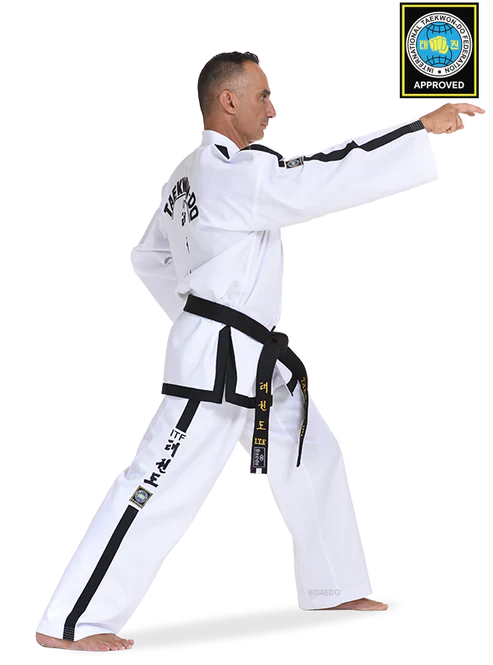The History of the Taekwondo Uniform (Dobok) — From Tradition to Today | AksportUS
A Taekwondo uniform may look simple — white jacket, pants, belt — but behind every dobok is a rich history, cultural meaning, and decades of evolution. When students and parents understand the story behind their uniform, they wear it with more pride, respect, and motivation.
At AksportUS, we believe students should know what their uniform represents — not just wear it, but *understand* it.
Where the Taekwondo Uniform Began
The modern Taekwondo uniform is inspired by centuries‑old Korean clothing traditions and early martial arts uniforms from Korea, Japan, and China. Before martial arts schools existed, Korean warriors trained wearing loose, breathable clothing designed for movement.
The idea of a clean, white uniform — symbolizing purity, discipline, and new beginnings — came later as Taekwondo schools formalized in the mid‑1900s.
Influence from Other Martial Arts
Taekwondo grew after World War II, when martial arts training spread internationally. Korean martial artists studied various fighting systems and adapted clothing styles.
Early Taekwondo uniforms were similar to judo and karate uniforms:
- Cross‑over jacket (wrap style)
- Thick collar
- Durable fabric for grappling
As Taekwondo evolved into a kicking‑focused sport, the uniform evolved with it.
Birth of the Modern Taekwondo Dobok
When Taekwondo became recognized worldwide and eventually an Olympic sport, the uniform was redesigned for speed, flexibility, and athletic performance.
The biggest change was the **V‑neck pullover design**, which:
- Prevents jacket from opening during kicks
- Allows faster movement
- Gives a clean and professional appearance
Today, most Taekwondo schools use the V‑neck pullover dobok standard.
Meaning Behind the White Color
White represents:
- Respect
- Discipline
- Self‑control
- Purity of intention
- A fresh beginning every class
Students learn that wearing white reminds them to keep a clear mind and respectful attitude.
The Role of the Taekwondo Belt
Belts were introduced to show progress and encourage goals. Originally there were only white and black belts, but more colors were added to help students see gradual growth.
Each belt represents a stage of learning — like seasons or levels of personal development.
Evolution of Fabrics & Comfort
Old doboks were thick and heavy. Modern uniforms — like those supplied by AksportUS — are designed for movement and comfort:
- Lightweight material
- Breathable fabric for sweat control
- Reinforced stitching for kicking practice
- Quick‑dry technology
- Comfortable waistbands for kids
Taekwondo became faster, so uniforms became lighter and smarter.
Uniform Trim & Black Collar
As ranking systems grew, the **black‑trim V‑neck** was introduced for black belts. It shows leadership and advanced knowledge.
Uniform trims also began symbolizing:
- Instructor rank
- Leadership teams
- Demonstration teams
- Competition athletes
Cultural Symbols in Modern Doboks
Many doboks include symbols or Korean calligraphy. These honor Taekwondo’s heritage such as:
- Taegeuk (philosophical balance)
- Korean Hangul writing
- National flag symbols
- Dojang logos
Uniform Customization for Schools
As Taekwondo spread globally, schools adopted patches and embroidery to show identity and unity.
AksportUS supports dojang branding with:
- Custom embroidery
- Logo printing
- Patches for uniforms and jackets
The uniform becomes a badge of belonging — and a symbol of family and community.
The Uniform in Modern Taekwondo
Today the dobok represents:
- Korean culture
- Olympic sport history
- Personal discipline and respect
- School pride and teamwork
Students around the world wear their uniforms to:
- Train confidently
- Bow to instructors and classmates
- Demonstrate control and discipline
- Celebrate cultural tradition
Why Students Feel Proud Wearing Their Dobok
A dobok makes students feel strong, focused, and part of something meaningful. Parents often see their child’s posture change — they stand taller, act calmer, and take pride in their training.
📌 *Insert AksportUS Traditional vs Modern Dobok Photo Here*
Final Thought
A Taekwondo uniform is part of a tradition thousands of years old. It is a symbol of respect, culture, and personal growth. When a student wears a dobok, they are joining a long history of martial artists who trained with honor and heart.
AksportUS is proud to support that journey with high‑quality uniforms that honor the past and support the future of Taekwondo training.
👉 Explore Taekwondo uniforms at AksportUS.com

